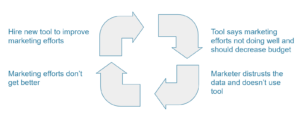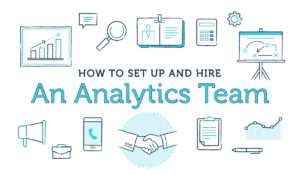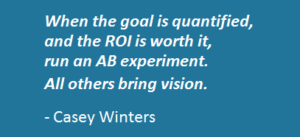My post on martech was surprisingly well received, so I thought I might go deeper on a particular area of martech that no one is happy with, but it seems very few people attempt to solve: marketing analytics. I’ll pull no punches here: marketing analytics is a bad business. Sure, there are successful marketing analytics companies, and you can definitely build a successful marketing analytics company now. But when people complain to me about marketing analytics, they complain about something specific; that the tools to help me understand how well my marketing efforts are doing are harder to use than they should be. Solving that is bad business. The reason is that great marketers don’t understand what most marketers are hiring analytics products to do.
What does an average marketer want at a larger organization? Cynically, I can boil it down to two things:
- To look good to their boss
- More budget
It really is that simple sometimes. Yes, there are marketers that are motivated by the truth whether it makes them look good or bad, and marketers who have recommended they should not spend money they are offered because they don’t think they can do it efficiently. I love those people (like the Eventbrite marketing team 🙂 ), but they are the minority. When you get to the enterprise, most people want one or both of the bullets above. So what do most marketing analytics tools that focus on understanding how well a marketer’s marketing efforts are doing actually do in practice? They tell the marketer one of two things:
- Their marketing spend is not efficient (read: they are not good at their job)
- They should be spending less than they are currently spending
They literally do the exact opposite role the marketer hired them to do. This creates the Marketing Analytics Death Spiral:
- They hire a tool to achieve marketing goals, for which their proxies are their current efforts making them looking good to their boss and getting more budget
- The tool tells them the opposite of their goals in Step 1
- They think they are good at their job and deserve more budget, so they naturally distrust the data from the tool
- Since they don’t use the data, their marketing efforts don’t get better
- They look for new tool
The addressable market for marketers who will be willing to have a tool show them how ineffective they are and will use that tool to improve over time is just too small. People who read my first post may ask: why not just change the target customer? Sure, you can target the finance team or the CEO, who may be less biased as to the effectiveness of a marketing team’s current programs. But then your product creates organizational friction between either two different functions or the CEO and the marketing function. This is a tough win condition for most forms of go-to market.
So what are companies doing instead in this space? Well, Amplitude and Mixpanel decided to focus on analytics for product instead of marketing. If product or engineering becomes the position of strength inside an organization, they can extend their tools into other functions like marketing over time. Many other marketing tools focus on making the marketer more efficient through automation. This makes them look better to their boss, which is exactly the job to be done for most marketers. Another variation that is successful is making something measurable in the first place that historically has not. This tends to solve job #2 for marketers of making budget available to them when it previously was not. For example, it was hard to measure mobile app campaigns before companies like AppsFlyer and Adjust came along, so no one was approving large app install ad budgets. Once these tools became available, marketers adopted them so they could prove their CPA’s were effective to get more budget.
—
The marketing analytics space is so tempting because budgets are large, and there are many unanswered questions. But you can’t forget the job to be done for marketers. If you’re not helping them look good or get more budget, your market size is going to be too small focusing on the few that are not motivated by that.
Currently listening to Let’s Call It A Day by Move D & Benjamin Brunn.





